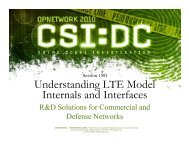Understanding TCP/IP Model Internals and Interfaces
Understanding TCP/IP Model Internals and Interfaces
Understanding TCP/IP Model Internals and Interfaces
Create successful ePaper yourself
Turn your PDF publications into a flip-book with our unique Google optimized e-Paper software.
1508 <strong>Underst<strong>and</strong>ing</strong> <strong>TCP</strong>/<strong>IP</strong> <strong>Model</strong> <strong>Internals</strong> <strong>and</strong> <strong>Interfaces</strong><br />
Results Analysis<br />
Congestion Window<br />
Examine <strong>TCP</strong> Connection.Congestion Window Size (bytes) graph to answer the following.<br />
To get an exact value, position your mouse in the desired region, <strong>and</strong> read the tooltip for the Nearest<br />
Point:<br />
1. What was the congestion window size before the packet loss was detected? ___________<br />
2. What did the congestion window size value change to after detecting packet loss? _________<br />
3. Why did the congestion window keep increasing after the loss was detected? ___________<br />
4. Why did the congestion window stay flat for a large period? ___________<br />
5. How did the server recover from packet loss—using fast retransmit or timeout retransmission?<br />
______________<br />
6. How many times was a slow start performed during the session lifetime? ___________<br />
Retransmission Pattern<br />
Examine sequence number of forwarded <strong>and</strong> dropped segments graph to answer the following.<br />
To get an exact value, position your mouse in the desired region <strong>and</strong> read the tooltip for the Nearest<br />
Point.<br />
7. How many segments were retransmitted? ___________<br />
8. Were any segments retransmitted unnecessarily? ___________<br />
9. When was the last segment sent? ___________<br />
Detailed Analysis (Homework)<br />
The size of the congestion window just before fast retransmission was 12,864 bytes. The congestion<br />
window after fast retransmission is reset to<br />
12,864 / 2 + 3 * MSS = 6,432 + 3 * 536 = 8, 040<br />
Note: In this calculation, when the congestion window is halved, it is rounded down to an integral<br />
multiple of the MSS. In this example, 12,864 is 24 * 536, the result of the division is also an integral<br />
multiple of the MSS. If the window had been 23 * 536 = 12,328, then the result would be 11.5 *<br />
536 = 6,164, which must be rounded down to 11 * 536 = 5,895.<br />
The sender then continues receiving more duplicate ACKs <strong>and</strong> increases its congestion window by<br />
one MSS for each ACK. At time 1.086 seconds, the ACK for retransmitted segment 23 takes the<br />
server out of fast recovery <strong>and</strong> the congestion window is set to half of the pre-fast retransmission<br />
value. The sender then receives 3 duplicate ACKs for segment 26 <strong>and</strong> resends segment 27 using the<br />
fast retransmission algorithm. However, because the server does not receive more ACKs, its<br />
congestion window could not increase further. To be able to send more data, it has to wait for the<br />
retransmission timer to expire. This increases application response time considerably.<br />
CONFIDENTIAL – RESTRICTED ACCESS: This information may not be disclosed, copied, or transmitted in any format without the prior written consent of OPNET Technologies, Inc.<br />
© 2010 OPNET Technologies, Inc.<br />
18
















